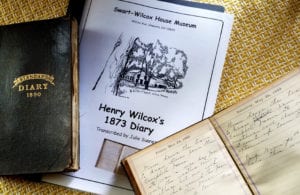HENRY WILCOX, IN HIS OWN WORDS
City Father’s Diaries
Being Transcribed By
Swart-Wilcox Friends
Some Of It Humdrum, Some Endearing

By LIBBY CUDMORE • Special to www.AllOTSEGO.com
ONEONTA – The Huntington Library didn’t know what it had.

When the Upper Susquehanna Historical Society – now the GOHS – was cleaning the Swart-Wilcox House for the 1976 Bicentennial, someone found all of Henry Wilcox’s diaries, said Helen Rees.
“They gave them to the Huntington Library and two were transcribed, but they didn’t think they were very important,” Rees said, founder of the Friends of the Swart-Wilcox House, Oneonta’s oldest home.
The diaries – seven in all – were later returned to the Friends. “We have very different views on what was important!” said Rees. “He wrote every day, so there are a very valuable insight into Oneonta’s life. He wrote about the weather, who died, what was going on.”
He wrote about his mother’s passing, his wife Phoebe and their sons Fred and Merton. A daughter, Myrtle, died at age 5 of “moreness” in 1875. The brothers were the last residents of the house.
In one diary, Henry wrote about making travel arrangements on the railroad – which could carrying him as far as Albany or Otego – only the find that it was often delayed.
“Went to Cobleskill and back to Oneonta at night the trail was two hours behind,” he wrote on Friday, Feb. 8, 1867.
“He really detailed the development of the railroads in Oneonta,” said Rees, who reported on her findings Sunday, June 16, at the first of weekly Sunday Summer Series presentations.
“Went from Oneonta to Bainbridge to see Selebration (at the opening of the Rail Road to that place talked with Mr. Skinner about selling the RR 500,00 ft Pine” (sic) he wrote on July 10, 1867.
Wilcox ran a lumberyard near today’s Main and River streets, in addition to his farming. “What I find fascinating is that he writes about being at the lumberyard on Thanksgiving and Christmas,” said Rees. “That means that people were buying lumber.”
On Christmas Day 1867, he wrote, “Was at Oneonta all day. My wife went down to Otego to keep Christmas with her folks. Received a check of $250 from J.C Ward & Son of Albany.”
“That means the post office was working on Christmas too!” she said.
In addition to the lumber and the farm, Wilcox also sold plots of land to the railroad workers, helping to develop the Sixth Ward from farmland into a neighborhood.
But his entries also show a turn from the young and energetic man of the house to a political force to be reckoned with.
“In 1890, he published a broadsheet about how there was no honest newspaper in the city,” she said. “He was down there paying taxes on all this land, and the city was putting lights and new roads up on Main Street and Walnut Street. That upset him.”
Titled “How To Make Business Good in Oneonta,” he satirizes the city. “Bond the town for $11,000 to build a bridge over the river” and “Mortgage the village with six fool trustees to throw away monies extorted from the taxpayers.”
He was later sued for $25,000 for passing out the broadside. He died at age 77 in 1912. No photo of the man has been found.
Though four diaries have been transcribed – 1874, 1885, 1875 and 1890 – Rees is still looking for people willing to transcribe Wilcox’s words.
“It makes a great winter activity,” she said. “And because he writes about so many Oneonta families – the Colliers and the Wilbers – that if you know anything about Oneonta, it’s a fun read.”
But be warned – it’s a labor of love. “He had good handwriting, but his spelling is atrocious,” she said. “He didn’t believe in capitalization or punctuation.”

